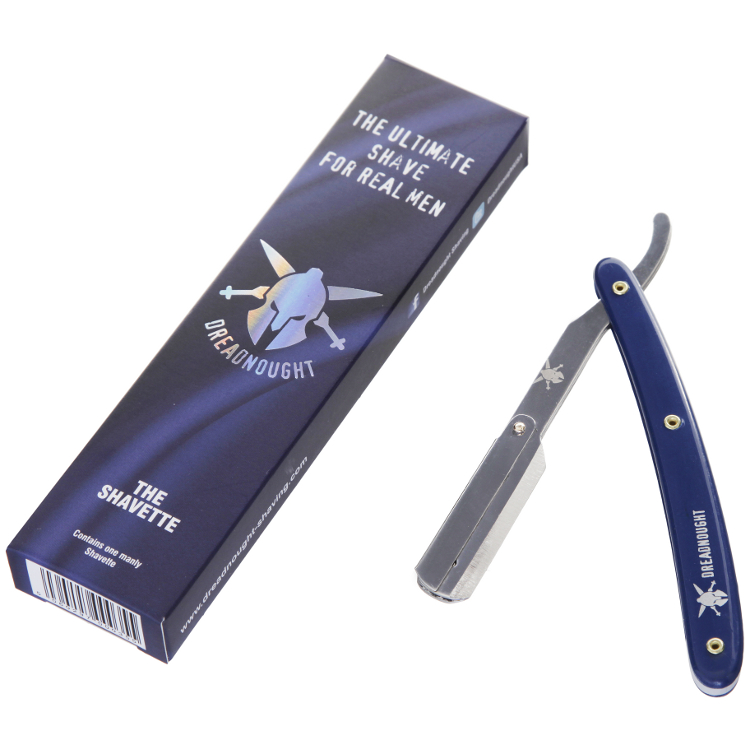Razors come in many different styles, grinds and tempers, and as such can be a daunting prospect for someone looking to buy their first. The question most often asked is, where do you start? This article will help guide you towards making that first, challenging step. Now that you have decided to buy a straight razor, you need to know that it is basically a simple shaving device. Unlike its multi-bladed counterparts, these have a single cut edge that can hold an incredible sharpness when honed properly.
Dovo Full Hollow Carbon Steel, 5/8″
Dovo Full Hollow Carbon Steel, 5/8″The handle portion of a straight razor, referred to as the “scales”, usually comprises of two separate pieces of celluloid, horn, bone, wood, mother of pearl or stainless steel. Exotic woods and materials are sometimes used when a straight razors existing scales become damaged, or the owner wishes to replace them. The scales are usually held together with brass pins and washers, one of which is located on the shoulder/tang of the blade which allows the razor to pivot into the open and closed positions. Most come with 2 pins though some can be found with 3. Generally speaking, 3 pins are used to provide greater strength to larger and heavier models.
DOVO, GB Buckingham & Sons Shaving Set
DOVO, GB Buckingham & Sons Shaving SetStraight razors do not have a locking function built into them, and are free to open and close with gentle pressure using the thumb. Great care must be taken when you first take hold of your razor and open and close it for the first time, regardless of how sharp the blade is. It is advised that you do this while seated, using a desk or table covered with a towel to control it’s action so that you can observe the correct usage of the razor without dropping it or cutting yourself. There are two types of metal used in the construction of the razor, carbon steel and stainless steel. Carbon steel is the most commonly used type of steel used due to it having softer properties than stainless and as such requires less time to produce a keen edge on it during the honing process.
Conk Shaving Brush

While this may seem off-putting at first having softer steel in your razor, the advantages far outweigh the use of stainless steel. The reason for this is that stainless steel is a much harder material and requires far greater effort to hone it. Stainless steel is also much easier to keep clean and is resistant to rust, something that it’s carbon brother is susceptible to. Regardless of which type of razor you end up buying, honing and maintenance will be a constant part of the ownership of a straight razor that is used on a daily basis, and it is always useful to apply a thin coat of mineral oil after every shave to protect the blade and inhibit rust. The razor blade edge is ground on the leading edge back up to the top edge of the razor where the material of the blade is at its thickest point. This is called the grind.
John Taylor Mineral Oil
John Taylor Mineral OilWhen razors are manufactured they are produced in a variety of different grinds according to the purpose, though generally it is considered that the best overall performing type of grind is the “hollow grind”. In the early days, manufacturing was actually done by hand, though later on newer technologies saw the grinding process move across to the machine made methods. The hollow ground is one of the most common grinds, but is not the only type of grind you will come across when looking to buy a new straight razor. Razors are also available in quarter ground, half ground and full wedge.
Dovo “Gentleman” Straight Razor
Dovo “Gentleman” Straight RazorHollow ground blades are the thinnest grind available and the full wedge is the thickest. The obvious difference is that the full wedge has the most metal in its construction and as such is preferred to cut thicker beards. The downside to full wedge ground razors is that they offer less feedback to the shaver and can be harder to learn with. It is suggested that your first straight razor should be a full hollow ground razor as they are easier to maintain and learn with.
Dreadnought Cut Throat Shavette

In addition to the grind of the blade, there is the “height” of the blade, referred to as the straight razors size. The largest manufactured size of a straight razor is 8/8 of an inch and decrements down to 3/8 at its smallest size. Larger sizes, like grinds, are preferred for cutting thicker beards, where 3/8 sizes are suitable for trimming moustaches. The size of the razor naturally relates to how much it will weigh, and this can affect the balance of it in your hand. To start with, a 5/8 or 6/8 blade for many people is an ideal size. Regardless of whether you have chosen to purchase your first straight razor second hand, or brand new from an on-line store, you will almost certainly have to hone the blade prior to use. This can seem particularly daunting as you will also have the task of learning how to shave too.
Professional 20″ in Leather Barber Razor Strop
Professional 20″ in Leather Barber Razor StropIt is highly recommended that when buying your first straight razor that you consider how you will get the razor adequately sharp for shaving with. One option is to purchase either a pasted strop or a suitable hone to sharpen your razor with, and learn how to do this yourself at the risk of damaging your rather through a lack of experience. Honing, like straight razor shaving and other parts of the straight shaving process, are techniques that take time to learn. Bear in mind that hones and pasted strops can be quite expensive, so many first time straight users end up looking for someone to hone their razor for them prior to its first use.
Most quality on-line straight razor specialist stores will offer the option to hone your straight razor for you before it is shipped out. This is highly desirable and costs relatively little against the expense of purchasing your own honing equipment. Recalling my first straight razor purchase, I found that buying a pre-honed razor was an excellent choice and took out the concerns over having a razor that was sharp enough to shave with straight out of the box, and through my personal use of the razor, I have not as yet, had to have my first razor re-honed after almost 9 months worth of use.
Instead, I chose to purchase a pasted 4-sided paddle strop a few months after buying my first straight razor, and re-sharpen it myself. This proved to be effective in keeping a keen edge on the razor, and deferred the expense of buying sharpening equipment which I chose to purchase later on once I had decided to maintain regular straight razor shaving. Now that you know the basics of how to go about getting your razor sharp enough there is another step that you need to take prior to each and every shave that you have with your razor, it is called stropping.
Premier Strop Co. 3″ Red Latigo with Handle
Premier Strop Co. 3″ Red Latigo with HandleA strop is simply a leather “strap” that comes in a variety of shapes, sizes and qualities of leather. The best type of strop to purchase initially is a double-sided hanging strop with a leather facing on one side and canvas on the other. Some strops have different grades of leather on both sides though this would mean that you would need to buy a separate canvas strop. The choice is yours. Prior to shaving you need to strop your straight razor on the canvas face first for a number of “laps”. A single lap consists of two strokes, one away, and one back. How much you will need to strop your razor prior to use varies, though commonly most people will perform 20 to 30 laps on the canvas side, followed by another 20 to 30 laps on the leather side. Stropping your straight razor on the leather side the final step before shaving with it.
The canvas side of the strop is fairly coarse and is designed to remove any residue that has been left behind after the last shave, and also “polish” the edge of the razor. The leather side of the face is almost sheer by comparison to the canvas side, and prepares the blade properly before shaving. Stropping the razor is absolutely vital and cannot be omitted from the preparation. Do not be tempted to use an old leather belt or home-made strop for this purpose as you will invariably end up damaging the edge of your straight razor and in the worst case you will have to throw your razor away. Something that you want to avoid. A strop is best hung from a metal hook that you will need to install somewhere in your home, preferably in the bathroom and not too close to water splashes as you will want to avoid getting your strop wet.
For this purpose, a marine-quality stainless hook is ideal, though not essential, and you may even attach your strop to a door handle or a attach a coat-hanger to a water pipe for the same purpose, though this is not recommended as you want to keep your strop taut and without horizontal movement. Like straight razor shaving, stropping is learned through experience and takes time to perfect. Do not rush your stropping technique or be too heavily influenced by videos of straight razor users performing 30 laps in a few seconds. Find the speed you are comfortable with, stick to it, and avoid rushing the process.
Eventually, despite stropping your straight razor on a regular basis, it will need re-honing by yourself or an expert. The cost of re-honing varies and it is not particularly expensive. You will know when your razor is not sharp enough as it will start to snag on your beard more often and cause more irritation to your skin. When this starts to happen, and your strop is no longer capable of keeping the razor sharp enough to shave with, it is time to think about re-honing. You should only need to think about re-honing a straight razor once or twice a year and searching for assistance on specialised straight razor shaving sites will put you in the right direction.
Remember that when your straight razor starts to snag on your beard, the likelihood of getting a nick or cut is greatly increased, so be aware of how sharp your blade is each and every time you shave with it. You will gain this observational skill automatically as you learn to shave over time and is all part of the enjoyable art of straight shaving. Buying your first straight razor need not be an expensive exercise. Many usable straight razors are available on eBay or through shaving forum classifieds for as little as £15 ($20), and can be as much as several hundred. The cost does not reflect how well it will shave, so don’t be tempted to spend a small fortune on your first straight razor. Also be aware that auction bought razors are usually sold “as-is”, and are not sharp enough to shave with.
You may be tempted by the scale design, blade detailing, or the aesthetics of a particular straight razor, and this is all part of buying one, though it should be emphasized that first and foremost it is important that your chosen straight razor is capable of giving you an excellent shave. This advice is best sought from specialist forums, so take your time and enjoy using these valuable resources. You will be welcomed with open arms by a community of people who have a vast knowledge of straight razor shaving and will be pleased to help you. I hope you have found this article useful and that you enjoy buying your first straight razor!
For expert tips on how to master men’s grooming, check out Male Standard.com!

